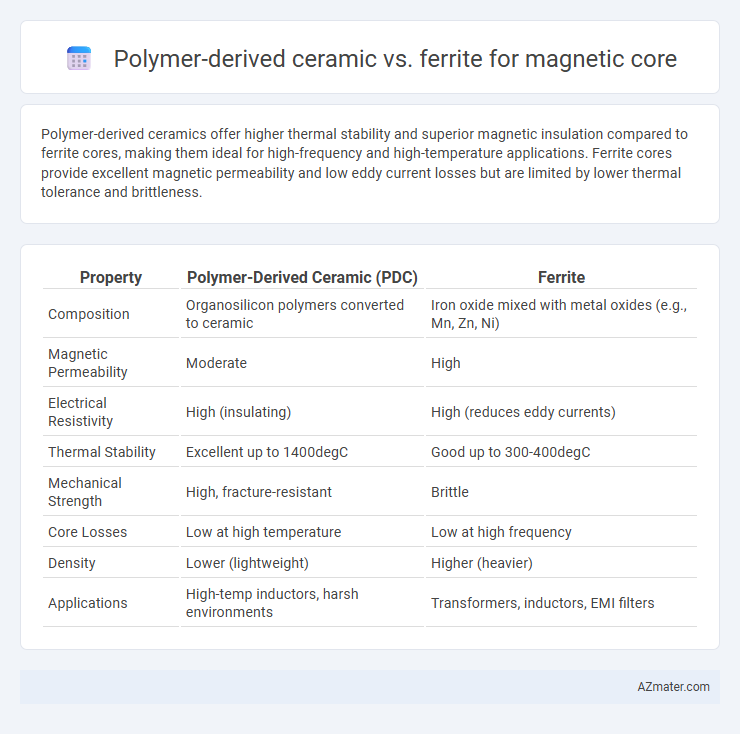Polymer-derived ceramics offer higher thermal stability and superior magnetic insulation compared to ferrite cores, making them ideal for high-frequency and high-temperature applications. Ferrite cores provide excellent magnetic permeability and low eddy current losses but are limited by lower thermal tolerance and brittleness.
Table of Comparison
| Property | Polymer-Derived Ceramic (PDC) | Ferrite |
|---|---|---|
| Composition | Organosilicon polymers converted to ceramic | Iron oxide mixed with metal oxides (e.g., Mn, Zn, Ni) |
| Magnetic Permeability | Moderate | High |
| Electrical Resistivity | High (insulating) | High (reduces eddy currents) |
| Thermal Stability | Excellent up to 1400degC | Good up to 300-400degC |
| Mechanical Strength | High, fracture-resistant | Brittle |
| Core Losses | Low at high temperature | Low at high frequency |
| Density | Lower (lightweight) | Higher (heavier) |
| Applications | High-temp inductors, harsh environments | Transformers, inductors, EMI filters |
Introduction to Magnetic Core Materials
Polymer-derived ceramics offer high thermal stability and customizable magnetic properties, making them ideal for advanced magnetic core applications. Ferrite cores, widely used in inductors and transformers, provide excellent magnetic permeability and low eddy current losses due to their high electrical resistivity. The choice between polymer-derived ceramics and ferrites depends on specific performance requirements such as operating frequency, temperature tolerance, and mechanical durability.
Overview of Polymer-Derived Ceramics
Polymer-derived ceramics (PDCs) offer superior thermal stability and chemical resistance compared to traditional ferrite cores, making them ideal for high-frequency and high-temperature magnetic applications. PDCs are synthesized through the pyrolysis of preceramic polymers, resulting in amorphous or nanocrystalline ceramic structures with excellent mechanical strength and dielectric properties. Their tunable magnetic permeability and low eddy current losses enable enhanced performance in compact inductors and transformers, outperforming ferrites in harsh environments.
Fundamentals of Ferrite Magnetic Cores
Ferrite magnetic cores are composed of iron oxide combined with other metallic elements, exhibiting high electrical resistivity and low eddy current losses, which are essential for efficient magnetic performance at high frequencies. Unlike polymer-derived ceramics, ferrites provide superior magnetic permeability and low coercivity, making them ideal for inductors and transformers in power electronics. Their ferrimagnetic properties and stable thermal characteristics underpin their widespread use in magnetic core applications demanding minimal energy dissipation and consistent magnetic behavior.
Magnetic Properties Comparison
Polymer-derived ceramics (PDCs) exhibit higher temperature stability and superior electrical resistivity compared to ferrite cores, enhancing magnetic performance at elevated frequencies. Ferrite cores demonstrate higher initial permeability and lower core losses at standard operating frequencies, making them ideal for low-frequency applications. The intrinsic microstructure differences result in PDCs offering improved mechanical strength and thermal conductivity, while ferrites provide superior magnetic saturation and lower hysteresis losses.
Electrical Performance and Efficiency
Polymer-derived ceramics (PDCs) exhibit high electrical resistivity and thermal stability, reducing eddy current losses and enhancing efficiency in high-frequency magnetic cores compared to ferrites. Ferrites, characterized by moderate electrical resistivity and lower saturation magnetization, perform well at lower frequencies but suffer increased core losses at higher frequencies. The inherent electrical insulation and tunable magnetic properties of PDCs enable superior electrical performance and energy efficiency in demanding electromagnetic applications.
Thermal Stability and Heat Resistance
Polymer-derived ceramics exhibit superior thermal stability and heat resistance compared to ferrite cores, maintaining magnetic properties at temperatures above 1000degC, whereas ferrites typically degrade beyond 300-400degC. The amorphous and covalent bonding structure of polymer-derived ceramics enables them to withstand thermal shocks and prevent oxidation at elevated temperatures. This makes polymer-derived ceramic cores ideal for high-frequency and high-temperature applications in power electronics and aerospace industries.
Mechanical Strength and Durability
Polymer-derived ceramic magnetic cores exhibit superior mechanical strength and enhanced durability compared to ferrite cores due to their amorphous microstructure and resistance to thermal shock. These ceramics maintain structural integrity under high-temperature conditions and cyclic mechanical stresses, making them ideal for demanding applications. Ferrite cores, while cost-effective and magnetically efficient, tend to be brittle and susceptible to cracking under mechanical strain, limiting their lifespan in harsh environments.
Cost and Manufacturing Considerations
Polymer-derived ceramics typically offer lower raw material costs and enable complex shapes through molding or 3D printing, reducing manufacturing expenses compared to ferrite cores, which require high-temperature sintering and machining. Ferrite cores, while often more expensive due to energy-intensive processing, provide consistent magnetic properties suitable for high-frequency applications, but their production is less adaptable to intricate geometries. Choosing polymer-derived ceramics can optimize cost efficiency and customization in magnetic core manufacturing, especially for low- to mid-frequency devices.
Application Suitability and Industry Use-Cases
Polymer-derived ceramics offer high-frequency stability, thermal resistance, and miniaturization benefits, making them ideal for advanced electronics and aerospace magnetic cores. Ferrite cores exhibit excellent magnetic permeability and low eddy current losses, favoring applications in power transformers, inductors, and telecommunications. Industries such as automotive and renewable energy prefer ferrite for cost-effective power management, while polymer-derived ceramics are gaining traction in high-performance, miniaturized, and high-temperature environments.
Future Trends in Magnetic Core Materials
Polymer-derived ceramics (PDCs) offer superior thermal stability and mechanical strength compared to traditional ferrite materials, enabling enhanced performance in high-frequency and high-temperature applications. Future trends indicate a growing integration of PDCs with nanostructured ferrites to achieve improved magnetic saturation and reduced core losses. Advances in additive manufacturing and nanocomposite synthesis are expected to drive the development of hybrid magnetic cores combining the advantages of polymer-derived ceramics and ferrite materials.

Infographic: Polymer-derived ceramic vs Ferrite for Magnetic core
 azmater.com
azmater.com